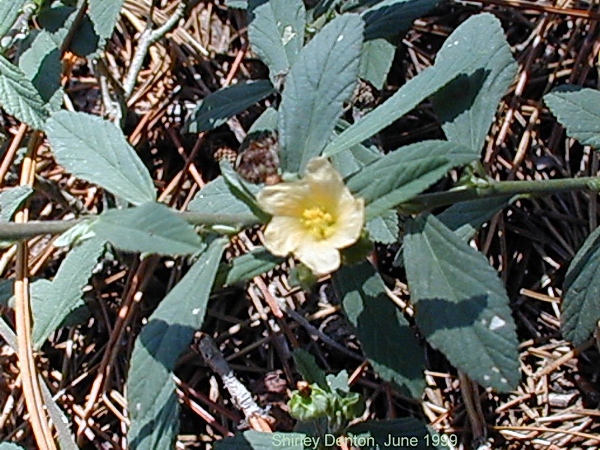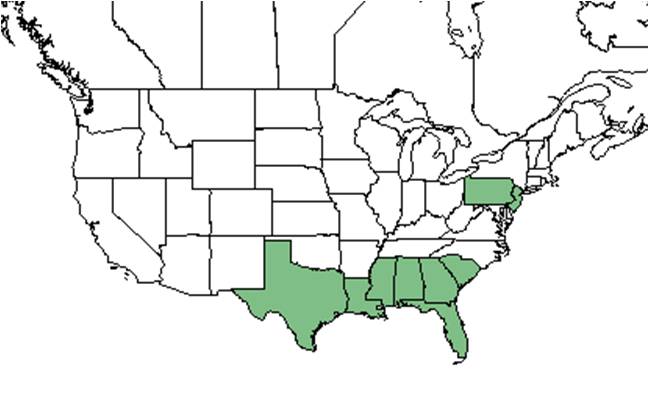Sida acuta
| Sida acuta | |
|---|---|

| |
| Photo by Shirley Denton (Copyrighted, use by photographer’s permission only), Nature Photography by Shirley Denton | |
| Scientific classification | |
| Kingdom: | Plantae |
| Division: | Magnoliophyta - Flowering plants |
| Class: | Magnoliopsida – Dicotyledons |
| Order: | Malvales |
| Family: | Malvaceae |
| Genus: | Sida |
| Species: | S. acuta |
| Binomial name | |
| Sida acuta Burm. f. | |

| |
| Natural range of Sida acuta from USDA NRCS Plants Database. | |
Common name: common wireweed
Contents
Taxonomic notes
The specific epithet means sharpened to a point, in reference to the tip of the leaves[1].
Description
Erect branched suffrutex up to 1 meter tall, rarely taller. Green stems, mostly hairless to stellate-hairy, particularly on younger parts. Leaves more or less narrowly lanceolate, 2-6(10) cm long; apex acute; base obtuse to rounded, hairless to sparsely stellate-hairy; margin regularly serrate; petiole c. 2.5 mm, pubescent. Stipules linear, usually longer than the petiole. Flowers axillary, solitary or 2 together. Calyx 6-8 mm long, somewhat angular, saucer-shaped, hairless, lobed to the middle; petals as long as calyx, yellow. Mericarps 5-6, c. 4 mm long, birostrate, grooved between the awns[2].
Distribution
Distributed from South Carolina throughout Florida and west to Mississippi[1].
Ecology
Habitat
Occurs in dry and moist deciduous forests[1]. In Northern Australia, it is classified as an invasive species and dominates improved pastures, disturbed areas and roadsides[3].
Phenology
Flowers are borne singly or in small clusters in the leaf forks on short stalks. Flowers have 5 yellow petals and 5 sepals[4].
Seed dispersal
Seeds have two sharp awns that easily attach to animals and clothing[5].
Seed bank and germination
Seeds have an innate dormancy period, the embryo requiring a post-ripening period of 1 to 3 months at high temperatures before germinating[5].
Fire ecology
Pollination
The following Hymenoptera families and species were observed visiting flowers of Sida acuta at Archbold Biological Station (Deyrup 2015):
Halictidae: Augochlorella gratiosa
Use by animals
Diseases and parasites
Conservation and Management
Cultivation and restoration
Photo Gallery
References and notes
Deyrup, M.A. and N.D. 2015. Database of observations of Hymenoptera visitations to flowers of plants on Archbold Biological Station, Florida, USA.
- ↑ 1.0 1.1 1.2 [[1]]Eat the Weeds. Accessed: March 14, 2016
- ↑ [[2]]Encyclopedia of Life. Accessed: March 15, 2016
- ↑ Flanagan, G. J., L. A. Hills, et al. (2000). "The successful bioloical control of spinyhead Sida, Sida acuta [Malvaceae], by Calligrapha pantherina in Australia's Northern Territory." Proceedings of the X International Symposium on Biological Control of Weeds
- ↑ [[3]]Accessed: March 15, 2016
- ↑ 5.0 5.1 Lonsdale, W. M., G. Farrell, et al. (1995). "Biological Control of a Tropical Weed: A Population Model and Experiment for Sida acuta." Journal of Applied Ecology 32(2): 391-399.